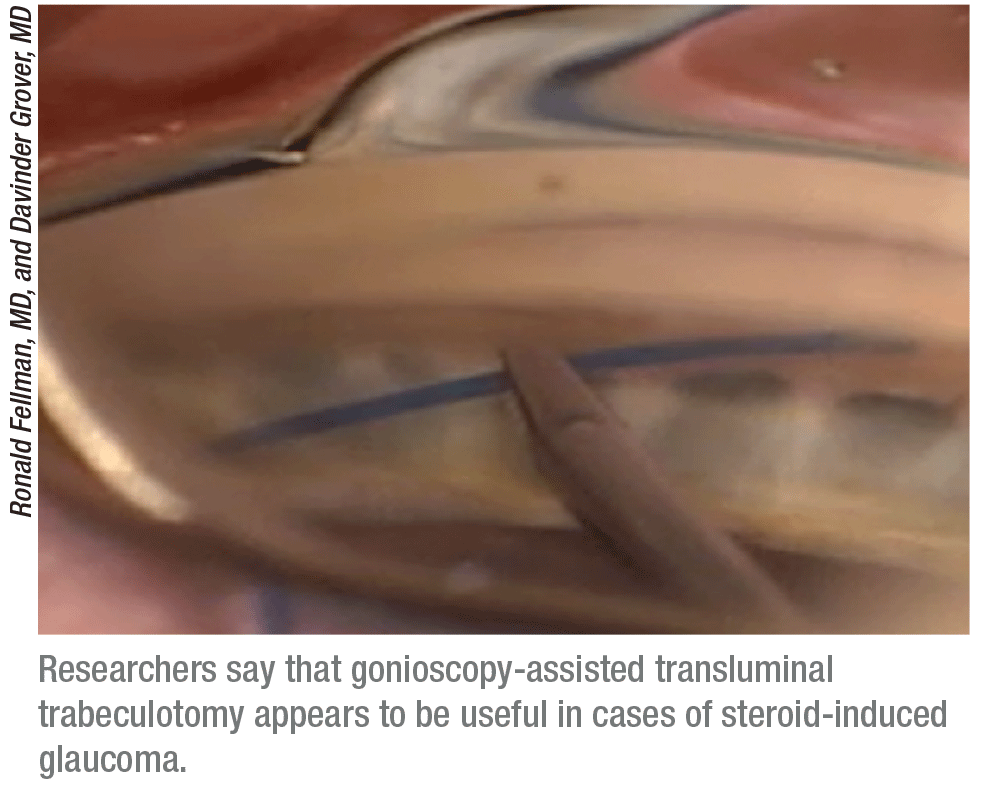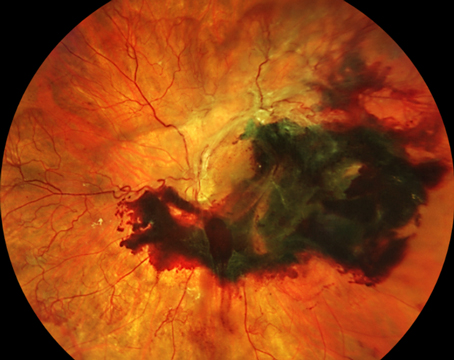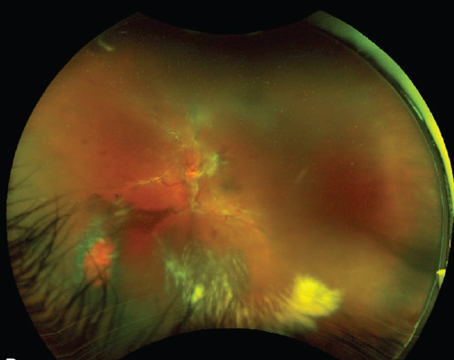In a randomized, prospective, double-masked clinical trial, researchers sought to compare the injection frequency of aflibercept and ranibizumab in the treatment of macular edema secondary to central retinal vein occlusion. According to previous in vitro studies, aflibercept was shown to have a significantly higher affinity to VEGF-A than ranibizumab, and mathematical models suggest aflibercept’s VEGF-binding effect lasts longer. (Other studies have failed to confirm differences in binding effect between the two drugs.)
The researchers randomized 45 patients with treatment-naïve CRVO and macular edema into two groups for receiving injections of aflibercept (n=22) or ranibizumab (n=23). A treat-and-extend regimen with an 18-month follow-up period was used. Treatment intervals were extended from two to 12 weeks after three loading doses, and intervals were shortened by two weeks if macular edema recurred.
The researchers found that the mean number of injections given in the aflibercept group was significantly lower than in the ranibizumab group, with a mean of 10.9 injections of aflibercept and 14.4 of ranibizumab at study completion. Treatment intervals in the aflibercept group were significantly longer than in the ranibizumab group, with intervals of 10 and 6.6 weeks, respectively.
The study concluded that aflibercept has a longer duration of effect than ranibizumab for treating macular edema following CRVO in a treat-and-extend regimen. Aflibercept reduced the need for injections by 24.3 percent during the study period. The study also found that visual outcomes between the two groups were similar, leading the researchers to conclude that treatment burden can be reduced without negative impact on visual outcome.
Retina 2019;39:7:1370-1376
De Salles MC, Amrén U, Kvanta A, and Epstein DL.
What’s in the Syringe?
Anti-VEGF injections have become the most commonly performed procedure in ophthalmology, thanks to the high volume of patients requiring intravitreal injections over long-term periods. While most studies focus on technical aspects of anti-VEGF delivery, researchers in Tel Aviv decided to look at volume output of intravitreal drug delivery, since recent studies have shown that accuracy and reproducibility with typical syringes is highly variable.
The clinical study included 669 intravitreal injections with prefilled bevacizumab (n=432, 64.6 percent), prefilled ranibizumab (n=125, 18.7 percent) and aflibercept syringes (n=112, 16.7 percent). The injections were performed by six ophthalmologists, each doing at least 50 injections of all three drugs. Volume output was calculated as the difference in syringe weight before and after injecting the drug. Accuracy and precision were analyzed by mean absolute percentage error and coefficient of variation, respectively.
The study found that all volume outputs were significantly different from the target of 50 µL (p<0.0001 for all) with mean absolute percentage errors of 12.25 ±5.92 percent for bevacizumab, 13.6 ±8.75 percent for ranibizumab and 24.69 ±14.84 percent for aflibercept. Volume outputs for bevacizumab and ranibizumab were not significantly different, but both were significantly more accurate than aflibercept. The study authors note that prefilled syringes were associated with improved accuracy. They also found that overdelivery of anti-VEGF was highly common, though underdelivery occurred in 16.3 percent of injections. Overall, the authors conclude that the current practices for intravitreal injections are highly variable.
Retina 2019;39:7:1385-1391
Loewenstein I, Goldstein M, Moisseiev J, and Moisseiev E.
ELM Height for Macular Hole Prognosis
In a retrospective observational study of patients undergoing vitrectomy for macular hole surgery, researchers measured the greatest vertical height of the central external limiting membrane above the retinal pigment epithelium (ELM height) on spectral domain OCT. The goal of the study was to investigate the relationship of ELM height to pre- and postoperative variables, such as macular hole width and height and visual acuity.
Ninety-one eyes of 91 patients who had undergone surgery for idiopathic full-thickness macular hole were evaluated. ELM height ranged from 100 to 394 µm, with a mean of 220 µm. Researchers found significant correlations between ELM height and macular hole diameter and height, along with a worsening of postoperative visual acuity.
The study found that the higher the external limiting membrane height in idiopathic macular hole, the poorer the preoperative vision. A lower external limiting membrane height predicted better postoperative visual acuity for holes less than 400 µm in width. The researchers say that external limiting membrane height is a strong independent predictor of good postoperative outcomes.
Retina 2019;39:7:1392-1398
Geenen C, Murphy DC, Sandinha MT, Rees J, and Steel D.
GATT for Steroid-induced Glaucoma
Researchers evaluated the efficacy of gonioscopy-assisted transluminal trabeculotomy for lowering the intraocular pressure in steroid-induced glaucoma. They performed a retrospective chart review of all GATT procedures performed on individuals with a predominant diagnosis of steroid-induced glaucoma between March 1, 2016, and March 30, 2018, at the University of Michigan.
Primary outcome measures included IOP, the number of IOP-lowering medications prescribed and the topical steroid dosing over the duration of follow-up. A total of 13 individuals with steroid-induced glaucoma underwent the GATT procedure. Here are some of the findings:
 |
• A significant reduction in mean IOP was found at all postoperative visits.
• The average IOP decreased by 16.4 mmHg to 19.5 mmHg between three and 24 months postoperatively.
• By 24 months, all individuals had a reduction in IOP of >20 percent.
• The number of glaucoma medications decreased significantly from an average of 3.1 medications preoperatively to an average of 0.8 medications at last follow-up.
• The majority of individuals (>67 percent) required continued use of steroids at all postoperative visits. The most common postoperative complication was a transient hyphema (38 percent).
• No individuals required a repeat glaucoma surgery or anterior chamber washout.
Researchers wrote that their small case series suggested that GATT was an effective and safe surgical technique for decreasing IOP and decreasing medication burden in individuals with predominantly steroid-induced glaucoma. To their knowledge, this is the first study looking specifically at the efficacy of GATT for this condition.
J Glaucoma. 2019; Jun 27. [Epub ahead of print].
Boese EA, Shah M.
Late AMD in Fellow Eyes of Unilateral Cases
Investigators assessed whether the development of late age-related macular degeneration in fellow eyes with pseudodrusen was associated with the pseudodrusen pattern in individuals with unilateral exudative AMD, as part of a retrospective, observational study.
They performed a retrospective analysis on 73 individuals with unilateral exudative AMD showing pseudodrusen in their fellow eyes. Eyes were classified according to pseudodrusen pattern, which was determined based on maximum pseudodrusen ribbon length. Here are some of the study’s findings:
• During the mean follow-up period of 35.5 ±18.6 months, 21 (28.8 percent) eyes developed late AMD.
• Among these eyes, 15 (71 percent) developed exudative AMD and six (29 percent) developed geographic atrophy.
• Development of late AMD in fellow eyes occurred with significantly more prevalence in individuals showing a ribbon-dominant type of pseudodrusen pattern in their fellow eye than those showing a dot-dominant type (p=0.0005, log-rank test).
• Cox-regression analysis revealed that development of late AMD in fellow eyes was associated with the presence of ribbon-dominant pseudodrusen in fellow eyes (HR, 4.15; CI, 1.59 to 10.8), along with older age (HR, 1.10; CI, 1.03 to 1.17), a history of smoking (HR, 17.2; CI 1.11 to 263), presence of large soft drusen in the fellow eye (HR, 5.49; CI, 1.29 to 21.1) and retinal angiomatous proliferation (HR, 5.02; CI, 1.90 to 13.2).
Researchers determined that individuals with unilateral exudative AMD who had fellow eyes with ribbon-dominant pseudodrusen were likely to develop late AMD.
Jpn J Ophthalmol 2019; Jul 2. [Epub ahead of print].
Sakurada Y, Sugiyama A, Kikushima W, et al.





